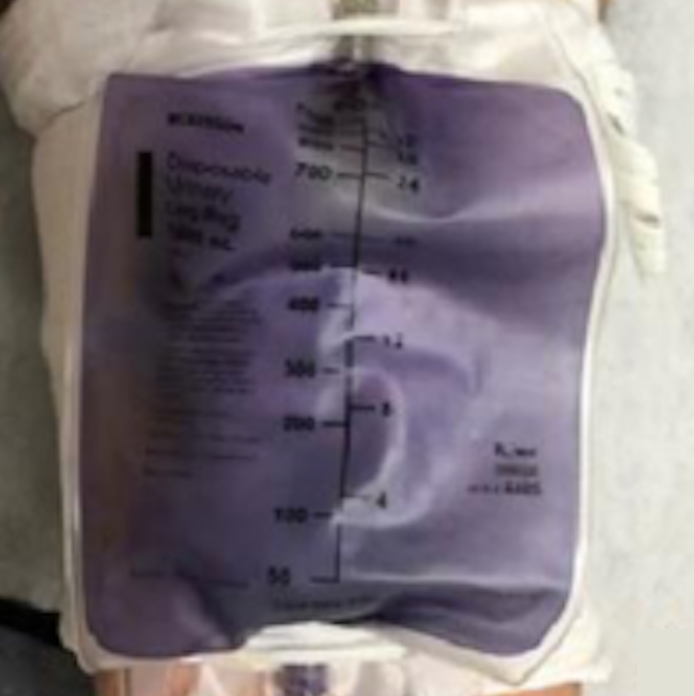A Case Report: An Unusual Presentation of Purple Urinary Bag Syndrome
DOI:
https://doi.org/10.38179/ijcr.v1i1.15Keywords:
purple urinary bag syndrome, PUBS, treatment, male, acidic urine, case reportAbstract
Background: The Purple Urinary Bag Syndrome (PUBS) is an uncommon and under-reported syndrome. It results from the purple discoloration of urine by tryptophan-oxidizing bacteria in a favorable alkaline milieu and usually affects patients with indwelling catheters. Other risk factors include female gender, chronic constipation, tryptophan-rich diet, and cognitive impairment. Although asymptomatic in the majority of cases, PUBS may be the sole and earliest sign of an aggressive urinary tract infection, especially in elderly patients where the presentation may be atypical and associated with resistant organisms, such as Pseudomonas aeruginosa and Vancomycin-resistant Enterococci (VRE). Proper treatment consists of catheter replacement and antibiotic therapy, which is indicated only in the setting of symptomatic infections.
Case Presentation: We report an unusual presentation of PUBS in a 79-year-old male patient with no classical risk factors. The patient had a supra-pubic catheter for urinary retention secondary to urethral strictures. Every month, by the time of catheter exchange, the patient developed an asymptomatic purple discoloration of the urinary bag, which was not investigated until he presented at our facility. Urine analysis revealed acidic urine. Appropriate antibiotic therapy was initiated after the development of urinary symptoms, and the catheter was replaced. No recurrent urine discoloration occurred.
Conclusion: This case represents the rare occurrence of PUBS in the setting of a suprapubic catheter in a male patient. It also highlights that even in atypical presentations, antibiotic therapy should be tailored to the clinical status of the patient and not the mere presence of bacteriuria. Raising awareness about this “esoteric” syndrome is essential for early diagnosis and proper management.
References
Khan F, Chaudhry MA, Qureshi N, Cowley B. Purple urine bag syndrome: an alarming hue? A brief review of the literature. Int J Nephrol. 2011;2011:419213. https://doi.org/10.4061/2011/419213. Epub 2011 Oct 1. PMID: 21977321; PMCID: PMC3184437.
Dealler SF, Hawkey PM, Millar MR. Enzymatic degradation of urinary indoxyl sulfate by Providencia stuartii and Klebsiella pneumoniae causes the purple urine bag syndrome. J Clin Microbiol. 1988 Oct;26(10):2152-6. PMID: 2846640; PMCID: PMC266835.
Lin CH, Huang HT, Chien CC, Tzeng DS, Lung FW. Purple urine bag syndrome in nursing homes: ten elderly case reports and a literature review. Clin Interv Aging. 2008;3(4):729-34. https://doi.org/10.2147/cia.s3534. PMID: 19281065; PMCID: PMC2682405.
Lin J, Hlafka M, Vargas O, Bhattarai M. Recurrent purple urine bag syndrome presenting with full spectrum of disease severity: case report and review of literature. CEN Case Rep. 2016 Nov;5(2):144-147. https://doi.org/10.1007/s13730-016-0213-6. Epub 2016 Jan 25. PMID: 28508966; PMCID: PMC5411640.
Bhattarai M, Bin Mukhtar H, Davis TW, Silodia A, Nepal H. Purple urine bag syndrome may not be benign: a case report and brief review of the literature. Case Rep Infect Dis. 2013;2013:863853. https://doi.org/10.1155/2013/863853. Epub 2013 Jun 20. PMID: 23864970; PMCID: PMC3705812.
Sabanis N, Paschou E, Papanikolaou P, Zagkotsis G. Purple Urine Bag Syndrome: More Than Eyes Can See. Curr Urol. 2019 Nov;13(3):125-132. https://doi.org/10.1159/000499281. Epub 2019 Nov 13. PMID: 31933590; PMCID: PMC6944938.
Traynor BP, Pomeroy E, Niall D. Purple urine bag syndrome: a case report and review of the literature. Oxf Med Case Reports. 2017 Nov 1;2017(11):omx059. https://doi.org/10.1093/omcr/omx059. PMID: 29744118; PMCID: PMC5934649.
Pandey S, Pandey T, Sharma A, Sankhwar S. Purple urinary bag syndrome: what every primary healthcare provider should know. BMJ Case Rep. 2018 Jul 18;2018:bcr2018226395. https://doi.org/10.1136/bcr-2018-226395. PMID: 30021748; PMCID: PMC6058161.
Chung SD, Liao CH, Sun HD. Purple urine bag syndrome with acidic urine. Int J Infect Dis. 2008 Sep;12(5):526-7. https://doi.org/10.1016/j.ijid.2008.02.012. Epub 2008 May 29. PMID: 18514009.
Raymond JR, Yarger WE. Abnormal urine color: differential diagnosis. South Med J. 1988 Jul;81(7):837-41. https://doi.org/10.1097/00007611-198807000-00008. PMID: 3393939.
Plaçais L, Denier C. Purple Urine after Catheterization. N Engl J Med. 2019 Oct 31;381(18):e33. https://doi.org/10.1056/NEJMicm1905446. PMID: 31665581.
Domínguez Alegría AR, Vélez Díaz-Pallares M, Moreno Cobo MA, Arrieta Blanco F, Bermejo Vicedo T. Síndrome de la orina morada en bolsa en paciente anciana con suplementos nutricionales [Purple urine bag syndrome in elderly woman with nutritional supplements]. Nutr Hosp. 2012 Nov-Dec;27(6):2130-2. Spanish. https://doi.org/10.3305/nh.2012.27.6.6054. PMID: 23588467.
Enganti B. Purple Urine Bag Syndrome- A Rare Clinical Entity in Chronic Urinary Catheterization: A Case Series and Literature Review. Urology & Nephrology Open Access Journal. 2015;2(5). https://doi.org/10.15406/unoaj.2015.02.00057
Yaqub S, Mohkum S, Mukhtar KN. Purple urine bag syndrome: A case report and review of literature. Indian J Nephrol. 2013 Mar;23(2):140-2. https://doi.org/10.4103/0971-4065.109442. PMID: 23716923; PMCID: PMC3658294.

Published
How to Cite
Issue
Section
Copyright (c) 2020 International Journal of Clinical Research

This work is licensed under a Creative Commons Attribution 4.0 International License.







